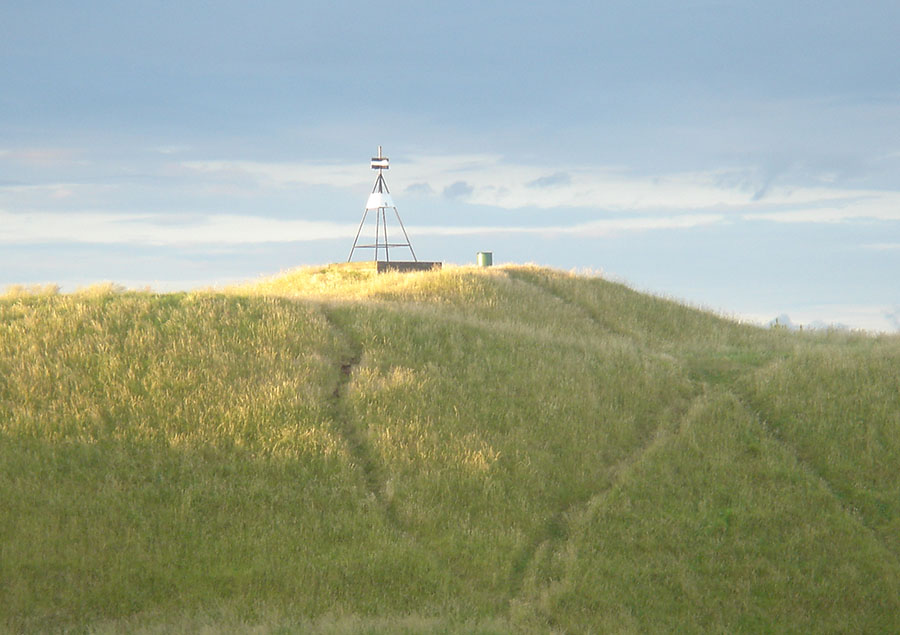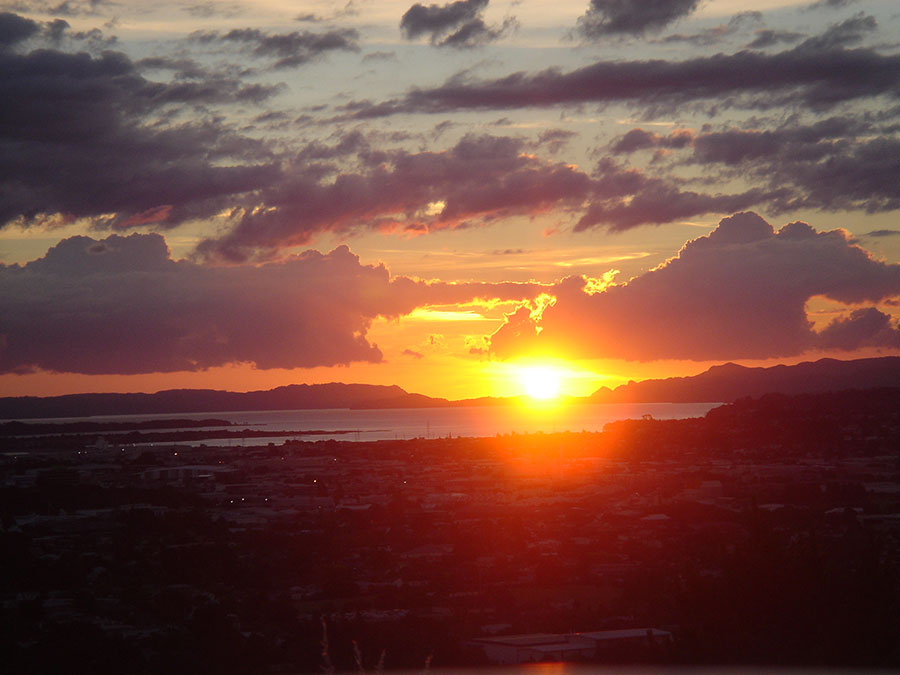

Beyond Bastion Point the next Port-of-call for the south running alignment is Mount Wellington.

We now arrive at Mount Wellington (Maungarei, meaning the watchful or sightful mountain), which has featured as one of the most important surveying trigs for New Zealand in the last 175-years or so of the colonial era. Surveyors of the 19th century, when setting up trig positions 100-miles northwards beyond Dargaville on the West Coast or inland locations, used Mount Wellington as the primary hub position, back to which all surveying lines resolved.
Maori names for places often reflect a Patu-paiarehe origin and function in their description, the language itself having clear Numidian-Libyan Semitic, Basque or Indo-Aryan and other Northern Hemisphere roots, which inspired New Zealand historian and surveyor, Edward Tregear to publish a book, The Aryan Maori, in 1885. To read the book online see:
https://archive.org/details/aryanmaori00treg
Of course Tregear’s very convincing and exhaustive study is scoffed at these days by the PC, racial-sensitivity brigade, as the implications are too terrible to contemplate. New Zealand regional history would be turned on its ear and the conclusions drawn would fly in the face of the cultural-Marxist agenda, where history has to support the requirements of the political organs.
One thing that Tregear overlooked was the fact that Maori, when they first arrived in New Zealand, by their own oral traditions admitted that they “had to live in sufferance under the mana of the Patu-paiarehe”. In other words, they spent perhaps a century or two gleaning information, skills, mythology, cultural-symbolism, dress and language, etc., from Patu-paiarehe/ Turehu society.
Later, according to Maori oral tradition, “war, strife, quarrelling came with Toi and his people”, which led to the total subjugation of Patu-paiarehe-Turehu society and the long era of rampant cannibalism, coupled with almost constant Maori intertribal warfare.
However, with the first visits of maritime explorers at the dawn of the colonial era for New Zealand many commented on the high incidence of very European-looking Maori.
Here is a quote:
'It is most certain that the whites are the aborigines. Their colour is, generally speaking, like that of the people of Southern Europe and I saw several who had red hair. There were some who were as white as our sailors and we often saw on our ship a tall young man who by his colour and features might easily have passed for a European' (see: Voyages To Tasmania & New Zealand, by Lt. Croset)...The above observation was made in the Bay of Islands, New Zealand.
'The Maori regales us with several tales that are supposed to illustrate a period when the Maori people were living here on sufferance, as it were, under the mana of the Turehu or Patupaiarehe, the true lords of the soil. Many different names are used to denote this forest folk or fairies as our writers often term them, though the Maori concept is not that of a diminutive fey or elf like folk, but rather that of a people of ordinary stature and appearance, save they are said to have been fair-skinned and fair haired' (see Maori Religion, by Elsdon Best).
It should be noted that Elsdon Best lived with the Maori people for over twenty years and was taught the deepest aspects of their history, religion and culture, to the extent that he was recognised as, or accorded the honour of becoming, a Tohunga (Priest).
‘Patupaiarehe is the name applied by the Maoris to the mysterious forest dwelling race. An atmosphere of mysticism surrounds Maori references to these elusive tribes of the mountains and the bush....The Patupaiarehe were for the most part of much lighter complexion than the Maoris...their hair was of a dull golden or reddish hue, "uru-kehu", as is sometimes seen amongst the Maoris of today...This class of folk-tales no doubt originated in part in the actual existence of numerous tribes of aborigines. This immeasurably ancient light haired people left a strain of uru-kehu in most ancient tribes' (see: The Journal of the Polynesian Society, volume 30, article by James Cowan).
Commenting on a later era, Cowan interviewed an old Maori elder who spoke of the Patupaiarehe of Mt. Ngongataha, Rotorua District. This partially wooded area rising above the south-west shore of Lake Rotorua was the main regional settlement of the Patupaiarehe, whom the old elder called, Ngati-Hua (hua means "bastard" in Maori and "Ngati" is generally placed before tribal names). The old elder described the former residents in the following way:
'The complexion of most of them was kiri puwhero (reddish skin) and their hair had a reddish or golden tinge we call uru-kehu. Some had black eyes, some blue like Europeans. Some of their women were very beautiful, very fair of complexion, with shining fair hair...'
Cowan was told by other Maori elders of the district that, “many generations previously, the Maoris set fire to the fern and forest on the slopes of the mountain, causing much anguish to the Patupaiarehe tribe and most of them departed northward”.
It's interesting to note that many very ornate little pataka buildings, like the ones in the Auckland War Memorial Museum, were seen abandoned and deteriorating, by early colonial observers, in the high country of Mt. Ngongataha.

A New Zealand pataka house, built in a very Anglo-Saxon, gable-roof style, unlike the round houses typically built throughout Polynesia. This one came from Rotorua district, where the highest lakeside mountain is Ngongataha. The house is represented as having been carved in the 19th century for a colonial collector, but weather-wear seems to indicate it was a much older building, simply dismantled and sold to the collector who, in turn, gifted it to the museum in his will or old age.
The doorway into the Pataka house is very small and designed for small stature people or children, most of who would still have to stoop in order to traverse the opening. Maori oral tradition tells us that one of the groups living in New Zealand and, more especially around the Taupo-Rotorua Lake districts, were “fair-skinned, much smaller in stature, with larger and very handsome features. The latter were the true urukehu and te whanau a rangi [children of heaven]. In some cases not only did they have reddish hair, but also light coloured eyes”.
(See: Tuwharetoa, chapter 7, page 115, by Rev. John Grace).
Other descriptions indicate that these people were about 4-feet in height or something equivalent to the stature of an 8-year old child. Legends, myths or stories of these “white-pygmies” abound from Ireland to the Americas to Tahiti and across the Pacific Ocean to New Caledonia and New Zealand. It was a common practice to use paua shell (abalone) to depict eye colours of green-blue on the statues and totem figures of these very intricately carved buildings and this is the case with this Pataka House at the Auckland Museum.

Also, from the Ngongataha vicinity is this ancient gateway from Pukeroa Pah, Rotorua and, again, paua shell has been used to depict the carved individual’s eyes as being coloured green-blue. The individual is also depicted as having a white-skin complexion. It’s well documented that Maori had to, both, widen & raise many of these doorways and gateways such that their own people could pass through them normally, another indication that the villages were acquired as the spoils of war from a defeated, vanquished people.
In a Waitangi Tribunal (Maori) discussion site, these words appeared:
‘The ancient people spoke ancient Maori, some were fair skin with red and silver blond hair, a race of peace people and healers. That is where Maori rongoa comes from.’
Early 20th century anthropologists studying the physical-anthropology of Pacific peoples came up with the following results:
The general biological anthropology of the Pacific is as follows:
"Negrito": oldest Polynesians - Northern Hawaiian chain (brachycephalism [short head] and platyrrhine [broad and flat-bridged nose])
"Negroid": confined to marginal islands of eastern Polynesia (dolichocephalism [long head] and platyrrhine)
"Malay": western Polynesia and southern Hawaii (brachycephalism and leptorrhine [long, narrow nose])
"Caucasoid": New Zealand and Hawaii (dolichocephalism and leptorrhine)
The Chatham Islanders (Moriori) – long heads, narrow noses, no prognathism, moderate stature = “primitive Caucasoid” type
The Caucasoid physical type being found in profusion at the south-west base of the vast Pacific Ocean represented a problem, as there was a wide region of Polynesia-Melanesia where the type was not found. The only conclusion one could draw was that a large Caucasoid (European) population was already in residence in New Zealand when the first Polynesians arrived in about 1250 AD.

A major, purpose-built feature of Mount Wellington is an ancient mound on the southern side of the crater rim, upon which stands a modern-day trig tower. From this position the summer solstice sun is seen to alight into a prominent and very conspicuous bowl or dip at Manukau Heads.

Ancient astronomer-priests could determine the day of the summer solstice with accuracy from the observatory mound atop Mount Wellington, as they saw the sun alight into a dip over towards Manukau Heads at the harbour inlet.